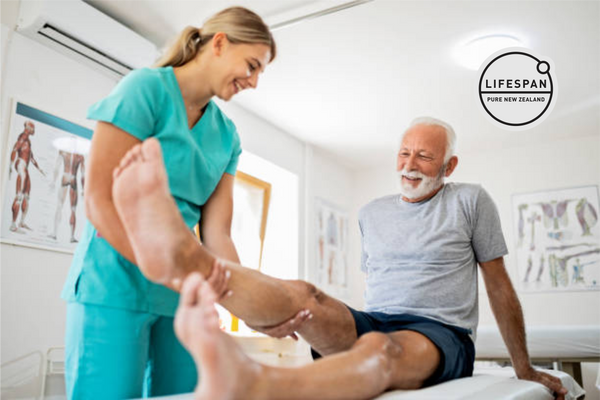
At Lifespan, we specialise in natural joint supplements.
Our premium range of supplements is designed to support and enhance joint health, providing essential nutrients that promote strength and flexibility.
With a commitment to purity and effectiveness, our products are formulated to offer comprehensive support for your joints, aiding in mobility and comfort.
Whether you're looking to maintain optimal joint health or address specific concerns, Lifespan's joint supplements are your ideal choice for a balanced and active lifestyle.
Recent posts
-

-
 Back Health, Nutrition, Exercise and Joint SupplementsBy Ben Winters
Back Health, Nutrition, Exercise and Joint SupplementsBy Ben Winters -
 Wrist Joint Supplements, Nutrition and ExerciseBy Ben Winters
Wrist Joint Supplements, Nutrition and ExerciseBy Ben Winters -
 Hip Joint Mobility and Natural SupplementsBy Ben Winters
Hip Joint Mobility and Natural SupplementsBy Ben Winters -
 Elbow Joint Supplements, Flexibility and HealthBy Ben Winters
Elbow Joint Supplements, Flexibility and HealthBy Ben Winters

About the Author
Ben Winters, experience and expertise to the world of joint supplements.
With a hands-on approach spanning from sustainable farming practices to advanced freeze-drying techniques, Ben ensures that Aroma NZ's joint supplement powder, a globally sought-after product, maintains the highest standards.
His deep involvement in every stage, from sourcing to final product, not only reflects his commitment to quality but also provides him with unique insights that enrich the content of his blogs, making them an invaluable resource for anyone interested in natural joint health solutions.

Knee Joint Supplements and Exercise
By Ben Winters
The knee joint allows us to walk, run, jump, sit, in fact most major movements involve the knee in some way, so maintaining its joint health through correct nutrition, exercise and joint supplementation is important.
Emphasising foods high in omega-3 fatty acids, glucosamine, and chondroitin can play a pivotal role in knee joint health. Omega-3-rich helps to support joint comfort, while glucosamine and chondroitin, both found in Green Lipped Mussel supplements, are associated with joint strength and flexibility.
Strengthening the knee is another aspect for maintaining mobility and ensuring long-term joint health.
A good way to start is with low-impact exercises that are designed to enhance the stability and flexibility of the knee without exerting undue stress.
Exercises such as swimming, cycling, and using an elliptical machine offer substantial benefits. These activities engage the muscles surrounding the knee, notably the quadriceps and hamstrings, in a gentle yet effective manner. By improving blood flow and reinforcing the supportive tissues, these exercises lay a solid foundation for a stronger knee joint structure.
As the knee gains strength and flexibility, incorporating weight-bearing exercises can add to its resilience.
Squats and lunges are beneficial, as they not only strengthen the muscles around the knee but also promote overall lower body strength. It is important though to ensure proper form and technique are used while performing these exercises to avoid any undue strain.

Gradually increasing the intensity and range of motion can lead to significant improvements in knee stability and function.
Resistance training, such as leg presses or leg extensions with light weights, can also be progressively introduced to challenge the muscles and enhance endurance.
Balance and proprioception exercises add another dimension to knee strengthening, emphasising the body's ability to control the position of the joint. Activities like yoga and Pilates focus on core strength, balance, and stability, contributing to a more centred and controlled movement.
These practices often involve poses and stretches that enhance the coordination and alignment of the knee, ensuring that it moves in harmony with the rest of the body.
Incorporating stability exercises, such as single-leg stands or the use of balance boards, can further train the knee to withstand various stresses, thereby improving its resilience and reducing the risk of injury.
Recovery and proper rest are just as important as the exercises themselves. After engaging in knee-strengthening activities, it is important to allow the muscles time to recover and heal.
Techniques such as gentle stretching, foam rolling, and the application of ice or heat can aid in this recovery process, alleviating any discomfort and preparing the knee for the next workout.
Additionally, staying consistent with a well-rounded exercise routine, coupled with adequate nutrition, joint supplements, and hydration, ensures that the knee joint, along with the entire body, remains strong, flexible, and capable of handling life's many activities.





